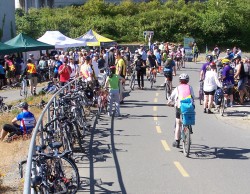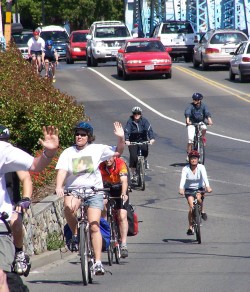Bike to Work Week: A Case Study in Successful Behavior Change
Victoria, British Columbia
Source: Pedestrian and Bicycle Information Center (PBIC)
Problem
Initially, Bike to Work events in Victoria, British Columbia inspired only committed cyclists to ride to work. An effort to convince provincial government employees to bicycle to work by linking the message to the province's own "green" initiatives was not recruiting new cyclists to bicycle commuting.
Background
Victoria is the provincial capital of British Columbia. The opportunity to increase bicycling mode share emerged there in the mid-1990s. The province wanted to centralize government services and increase office space downtown and was, concurrently, investing in major transportation infrastructure to accommodate growing suburban populations. The city government supported this development but pressured the province to limit the increased traffic that would result. The province embraced Transportation Demand Management (TDM) to respond to the city's needs and to accommodate an interest among provincial employees in choosing alternate modes. Cycling for transportation was put on the menu of TDM options.

Congestion on the Galloping Goose regional trail is so intense during BTWW that organizers must provide traffic control.
Photo: John Luton
The first iteration of Victoria's Bike to Work Week (BTWW) in 1995 was generated by government staff advocating for cycling as a transportation solution. It was supported almost exclusively by provincial funding. The event was attached to Canada's environment week; about 500 people (mainly provincial employees) participated. The challenge in growing BTWW was to decouple the effort to recruit people to cycle to work from superficially similar initiatives aimed at improving environmental citizenship.
Solution
Organizers soon realized that the event attracted committed cyclists, not the potential and non-cyclists who were their real targets. One highly-placed champion began to research behavior change theory and ultimately focused attention on this model as a way to accomplish the goal of recruiting employees to bicycle to work.
The behavior change model relied on research conducted by both the provincial and federal governments that identified barriers to cycling and reasons for choosing cycling. For most cyclists, health and personal fitness were the main motivators, with environment, for example, far down the list of behavior instigators. Key barriers included anxiety about safety, lack of confidence in traffic, concern about the time needed to ride to work and personal grooming issues.
BTWW organizers applied behavior change theory by narrowing the event's focus and discarding or changing components that didn't attract new cyclists.
| Early Elements... | Evolved into: |
| A share the road race that pitted one cyclist against one motorist in a race to the provincial legislature, to compare the travel time between a car and bicycle. | A commuter challenge, where 25 to 30 bicycle/driver pairs start from different locations and compete to arrive first at a common destination. Cyclists generally win at least half these races, even when starting 8 to 10 km from their destination. The race demonstrates that (1) commuter cycling is time-competitive with driving, and (2) replacing a vehicle commute with a bicycle commute is a time-efficient way to add a fitness routine to the daily schedule. |
| A free breakfast for participants provided by a local grocery chain. Food stations were set up at store locations for cyclists passing by on their way to work. | A series of "Celebration Stations" along key cycling corridors, particularly regional trails, offer refreshments and sell t-shirts. Sponsors may profile their businesses with free promotional material. |
| Recruiting and advertising a non-cyclist from a challenging demographic (female, middle aged, traffic averse) to bicycle to work for the first time. | A commuter skills course for cyclists who want to improve their skills and boost their confidence to ride in traffic. (This strategy has helped recruit significant numbers of women to cycling, improving their participation rates and establishing a sustainable program element eligible for different sources and types of funding.) In Victoria, the Capital Regional District Traffic Safety Commission has become the sponsor for Bike to Work Skills Courses. |
An essential part of the program (introduced some years after the inaugural event) is individual workplace recruitment. BTWW recruits team captains — individual champions in workplaces — and helps them market the program. Friendly competition between businesses or agencies to win prizes and bragging rights helps boost registration. The bicycle mode share at the several hundred workplaces that have established teams for Bike to Work Week is over 14 percent, almost double the mode share for commuter cycling recorded in Victoria's most recent studies.
In addition to these program elements, other factors contribute to successful behavior change and enhance the event:
- Specific focus on bicycling to work
- Behavior change triggers including multi-day exposure, reinforcements for trying, workplace based teams and employer approval
- Defining and targeting key demographics with messages about benefits to the individual
- Providing skill development for cyclists
- When possible, linking BTWW events to new or improved bicycle facilities that may make cyclists' routes to work more bicycle-friendly
- Experienced team captains to provide support and encouragement to workplace teams
- A skilled staff person to organize the commuter challenge and public events
- Partnerships with employers who endorse workplace teams and provide financial and in-kind support
- Capturing media coverage with public events, compelling stories, and by involving local prominent figures
- "Shoulder season" promotions (i.e., events that take place before and after BTWW in June) that remind the audience and the media that BTWW is a year-round program. Bike to Work Day in October encourages those who are still cycling to continue through the fall and winter. In March and April, the free Bike to Work Skills Course is offered to newer cyclists so they can develop the skills and confidence to join in BTWW.

Platoons of cyclists stream across Johnson Street Bridge during afternoon rush hour.
Photo: John Luton
Result
Bike to Work Week has grown from 1,075 participants in 1998 to 6,446 registered riders in 2008 (about 2 percent of the entire metropolitan census). There were no new cyclists at BTWW in 1998; in 2008, 979 new riders participated.
Bike to Work Week is first a marketing initiative and secondarily a cycling event. It has largely purged politics, partisanship and advocacy from the program, although its directors may work on cycling causes through other forums. It is marketing a behavior — commuter cycling. The program is aimed solely at enabling behavior change to increase bicycle mode share. Mode share of cycling for journey to work trips was 5.6 percent at the last census (2006). Local government research finds that 7.7 percent of afternoon peak-hour commute trips are by bicycle, better than all other cities in Canada by orders of magnitude.
BTWW's success is also reflected in the number of workplaces participating in the program: 679 teams registered in 2008. Smaller workplaces often have 100 percent participation. Cycling accounts for about 14 percent of all work trips in participating workplaces. This suggests that significant growth in commuter cycling can be encouraged by direct recruitment where people work.
The workplace team captains collect most of the participation data; this information is an important tool for recruiting and retaining sponsors, who want to know how many people their marketing dollars have reached. (A chart showing the event's growth 1998 - 2008 is here: http://www.biketowork.ca/files/images/Historical_Participation_Trends_08.pdf) Although no formal evaluation or survey has been done, many riders report on raffle forms or questionnaires that either they or someone they know started bicycling to work because of Bike to Work Week.
The BTWW Model
The Victoria model has spread successfully to other British Columbia communities over several years. BTWW plans to stage concurrent events across the province, assisting local communities with centralized services including graphics, brochures, posters, t-shirts, on-line support and registration. Bike to Work B.C., a single, province-wide organization, is being created to channel funding and provide support for new events. BTWW has also exported its template beyond British Columbia. Sacramento, California successfully adopted elements of Victoria's model in 2003; other U.S. and Canadian communities also have explored options to import the program.
Cost
BTWW was eventually established as a stand-alone non-profit organization. The event's cash budget has grown from $5,000 in 1995 to $110,000 in 2008. The province contributed $40,000 to the 2008 budget; in-kind contributions added another $60,000 - $70,000 in value to the total. The province has donated to the event regularly since its inception, but a new model is being considered that would fund the Bike to Work B.C. organization, which would in turn underwrite local programs.
BTWW's expenses include the significant costs of an executive director and paid staff, who are essential to the program's success. Other expenses include t-shirts, office rental, equipment purchases, etc. Funds are raised from various government departments and a diverse collection of private sector supporters who invest in the event as part of their corporate advertising and branding. Significant in-kind contributions, including free media advertising, also support BTWW.
The popular Bike to Work Skills Course (a free, seven-hour classroom and on-the-road training program) is now managed as a separate business entity within the organization with exclusive funding and dedicated staff time.
Web sites
Victoria's BTWW 2008: http://www.biketowork.ca/victoria/btww
Census data on bicycling in Canada:
http://www.statcan.ca/Daily/English/080402/d080402a.htm
http://www12.statcan.ca/english/census06/analysis/pow/26_victoria.cfm
Capital Regional District 2006 Origin and Destination Household Travel Survey:
http://www.crd.bc.ca/reports/regionalplanning_/generalreports_/transportation_/researchanddata_/householdtravelsurve_/2006_/crdodtravelsurveyfin/CRDODTravelSurveyFinalReport1_WITHCOVER.pdf
Contact
Stephanie Johnson
Executive Director, Bike to Work Victoria
Box 8837
Victoria, B.C. V8W 3S3
(250) 920-5775 (phone)
(250) 920-5773 (fax)
stephanie@biketowork.ca
www.biketowork.ca
Author
John Luton, Executive Director
Capital Bike and Walk Society
johnluton@shaw.ca
Image Sources
John Luton




